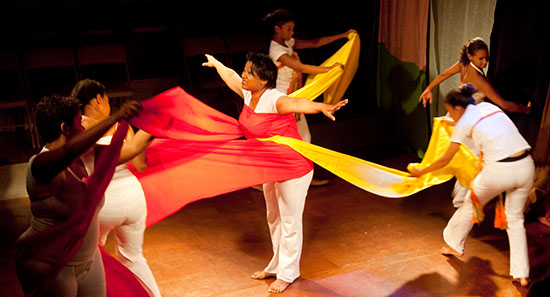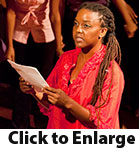Bending the Continuum
17/08/09 21:46 Filed in: Reviews
Published in the Trinidad Guardian on August 17, 2009.

Anushka Achan (centre) performs in Indra the Caterpillar, one of the children's stories in "The Little Stuff" by Continuum. Photography by Mark Lyndersay
The audience, it's safe to say, knew they weren't in for another dance recital from the first item on the show, The strange tale of an island shade, but the opening of Vapse, the closing piece, really pushed the boundaries of any conventional understanding of dance.
The dancers sat on the floor in the small theatre space of the Trinidad Theatre Workshop in Belmont and as the lights came up, slowly slid in a diagonal to the other side of the stage, making quirky snapping and chirping sounds and occasionally jerking and collapsing in spasms.
 These works are the first efforts of Continuum, a performance company created by dancer and choreographer Sonja Dumas to explore more fully her ideas for dance in the theatre. The company began working in 2004 as guests on Falling 2.0, a show by Dave Williams at the Central Bank.
These works are the first efforts of Continuum, a performance company created by dancer and choreographer Sonja Dumas to explore more fully her ideas for dance in the theatre. The company began working in 2004 as guests on Falling 2.0, a show by Dave Williams at the Central Bank.
Dumas has choreographed both experimental and more formal pieces for the Metamorphosis Dance Company, but these works are framed around the group of performers she has assembled to explore this aspect of her choreography and staging.
The works, performed to a small audience on August 08 with a repeat show the next night, were offered into two parts. The little stuff was staged as a more traditional matinee for children which staged three of Dumas' children's stories and later that night adults viewed the big stuff, the experimental works that she opens to audience discussion after each performance.
 Strange tale of an island shade was first performed for a small group of invited guests in May at the Cotton Tree Foundation and has since been revised to explore more of the stories of race that it weaves together in an interpretive analysis of colour, opportunity and the challenges of ethnic clarity and blending in Trinidad and Tobago society.
Strange tale of an island shade was first performed for a small group of invited guests in May at the Cotton Tree Foundation and has since been revised to explore more of the stories of race that it weaves together in an interpretive analysis of colour, opportunity and the challenges of ethnic clarity and blending in Trinidad and Tobago society.
"It's experimental dance performance," Dumas explained. "It's a laboratory for experimentation in movement, music and drama. I hope to bring a different set of aesthetic considerations to the audience, hoping to break the audience out of the expectations of a certain way of dancing to music."
"With the performers, I hope to encourage them on their journey to self expression. I explain to them that they will be interpreting this form in this space across this path and then they work with it."
Dumas choreographs the work, but it's a structured improvisation. Eighty percent of the work is defined by Dumas, but there is room for the dancers to use their own interpretation of the dance to define character and approach.
 Where Strange tale explores matters of race through a combination of spoken word, interpretive dance and often witty narrative segments, Vapse is far more abstract.
Where Strange tale explores matters of race through a combination of spoken word, interpretive dance and often witty narrative segments, Vapse is far more abstract.
"We explored the Gwo Ca, a Guadeloupean dance form, formalised by contemporary choreographer Lena Blou, who has worked with the native dance forms and movements in her country."
The sounds made by the performers in the opening of the piece are based on the Guadeloupean bigidi, a sound and movement combination that Dumas describes as a movement similar to the doption of the Baptist faith.
 Continuum plans to present a more formal staging of their works in October, including an expanded version of Strange tale and another work that departs from the minimalism of the young company's work thus far.
Continuum plans to present a more formal staging of their works in October, including an expanded version of Strange tale and another work that departs from the minimalism of the young company's work thus far.
"It requires a set, and that's going to cost some money that we don't have yet," Dumas explains. The company includes a number of performers, but it is, as the choreographer describes it, a pickup company.
"When there is a project, I ask people to be involved. There were eight people involved in this show, and we've had some help from Blue Culture with the music. It's more efficient to work that way in the local arts environment. We can't pay people to be around between projects, so all that's left is allowing the freedom to keep working."

Anushka Achan (centre) performs in Indra the Caterpillar, one of the children's stories in "The Little Stuff" by Continuum. Photography by Mark Lyndersay
The audience, it's safe to say, knew they weren't in for another dance recital from the first item on the show, The strange tale of an island shade, but the opening of Vapse, the closing piece, really pushed the boundaries of any conventional understanding of dance.
The dancers sat on the floor in the small theatre space of the Trinidad Theatre Workshop in Belmont and as the lights came up, slowly slid in a diagonal to the other side of the stage, making quirky snapping and chirping sounds and occasionally jerking and collapsing in spasms.

Dumas has choreographed both experimental and more formal pieces for the Metamorphosis Dance Company, but these works are framed around the group of performers she has assembled to explore this aspect of her choreography and staging.
The works, performed to a small audience on August 08 with a repeat show the next night, were offered into two parts. The little stuff was staged as a more traditional matinee for children which staged three of Dumas' children's stories and later that night adults viewed the big stuff, the experimental works that she opens to audience discussion after each performance.

"It's experimental dance performance," Dumas explained. "It's a laboratory for experimentation in movement, music and drama. I hope to bring a different set of aesthetic considerations to the audience, hoping to break the audience out of the expectations of a certain way of dancing to music."
"With the performers, I hope to encourage them on their journey to self expression. I explain to them that they will be interpreting this form in this space across this path and then they work with it."
Dumas choreographs the work, but it's a structured improvisation. Eighty percent of the work is defined by Dumas, but there is room for the dancers to use their own interpretation of the dance to define character and approach.

"We explored the Gwo Ca, a Guadeloupean dance form, formalised by contemporary choreographer Lena Blou, who has worked with the native dance forms and movements in her country."
The sounds made by the performers in the opening of the piece are based on the Guadeloupean bigidi, a sound and movement combination that Dumas describes as a movement similar to the doption of the Baptist faith.

"It requires a set, and that's going to cost some money that we don't have yet," Dumas explains. The company includes a number of performers, but it is, as the choreographer describes it, a pickup company.
"When there is a project, I ask people to be involved. There were eight people involved in this show, and we've had some help from Blue Culture with the music. It's more efficient to work that way in the local arts environment. We can't pay people to be around between projects, so all that's left is allowing the freedom to keep working."
blog comments powered by Disqus